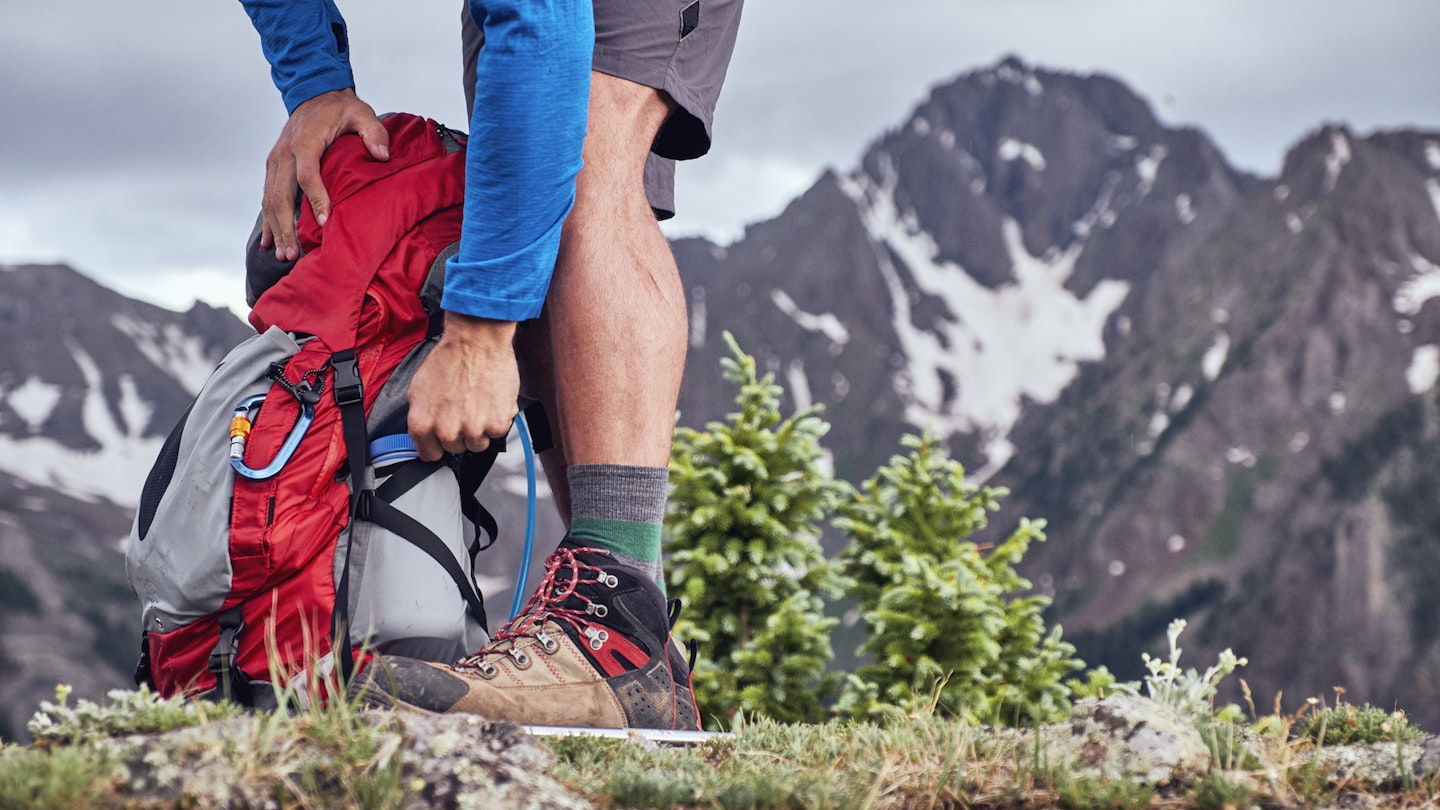If you’re off backpacking, on an expedition, or travelling, a rucksack of at least 50 litres needs to be one of your first purchases. It isn’t just a bag, it's your home, and you’re going to be living out of it. It needs to be big enough, robust enough, and comfortable enough to see you through and hold your essential kit. Simply, it's important. Below, we rank our favourite of the best 65L rucksacks available to help you find the one that works for you.
Finding the perfect backpack for you and your body type is a challenge, to be sure, especially if you're shopping online, so you have to be sure once you've decided on a rucksack. To combat this, we've selected countless one-size designs that are perfect for anyone, which use simple adjustment features that perfectly balance the backpack to your body type.
The best 65 litre rucksacks at a glance:
Going for a 65L rucksack might seem like overkill, but if you're planning on a long multi-day adventure with no shops in sight, packing well can save your life. There's no denying it, 65L rucksacks are a great size for anyone looking for a totally off-the-grid adventure.
There are a lot of solutions out there boasting a lot of features – some of them needed, some gimmicks. To cut through all the jargon, we’ve included a rundown of the essential features your bag will need.
Lid
The lid covers the top main opening to the backpack. These can be fixed to the rucksack or they may have a floating design that allows the main compartment to be extended vertically. To ensure water does not creep under a floating lid into the main compartment when the lid is extended a little, some designs also have a baffle linking the lid to the body of the sack.
Compression Straps
These straps are found on the sides of some rucksacks, and allow you to compress the body of the sack to help stabilise the load. They are also useful for stashing items onto the side of the pack, such as trekking poles or tent poles.
Ventilated Back System
Many rucksacks have mesh panels that hold the sack away from the body, to increase airflow and thereby reducing the horrid clammy sensation that some rucksacks produce. The greater the airflow across the back, the less clammy you will feel.
Wand Pockets
Originally designed for avalanche probes or ‘wands’, these pockets on the side of a rucksack are often made of stretchy mesh fabrics, and are ideal for stashing the ends of trekking poles, as well as smaller items including water bottles or snacks.
Hip Belt
This is designed to carry most of the load if the pack is heavy. It should fit snugly around your hips, be comfortable and easy to adjust, yet stiff enough to support the load without distorting too much. Rucksacks designed specifically for women are more likely to fit female body shapes better in this area.
Pockets
At least one external zipped pocket is useful for guidebooks, maps and GPS receivers, but some people like more, while others can tolerate less. Stretch pockets without zips are commonly placed on the front of the backpack, and these are ideal for stowing waterproof jackets between showers. Zipped side pockets are great for drinks bottles, flasks or food.
We’ve tried, tested, and reviewed many fantastic and not-so-fantastic rucksacks so we can bring you, with our utmost confidence, a definitive list of the best 55-65l rucksacks your money can buy. To help bust rucksack jargon, at the bottom of the page you will find a fitting guide and glossary. If you're not in need of such a huge capacity, consider a 30-35L backpack.
The best 65L rucksacks of 2024:
All prices are correct at the time of writing. Prices, stock and deals are subject to change without notice.
Best overall 65 litre backpack
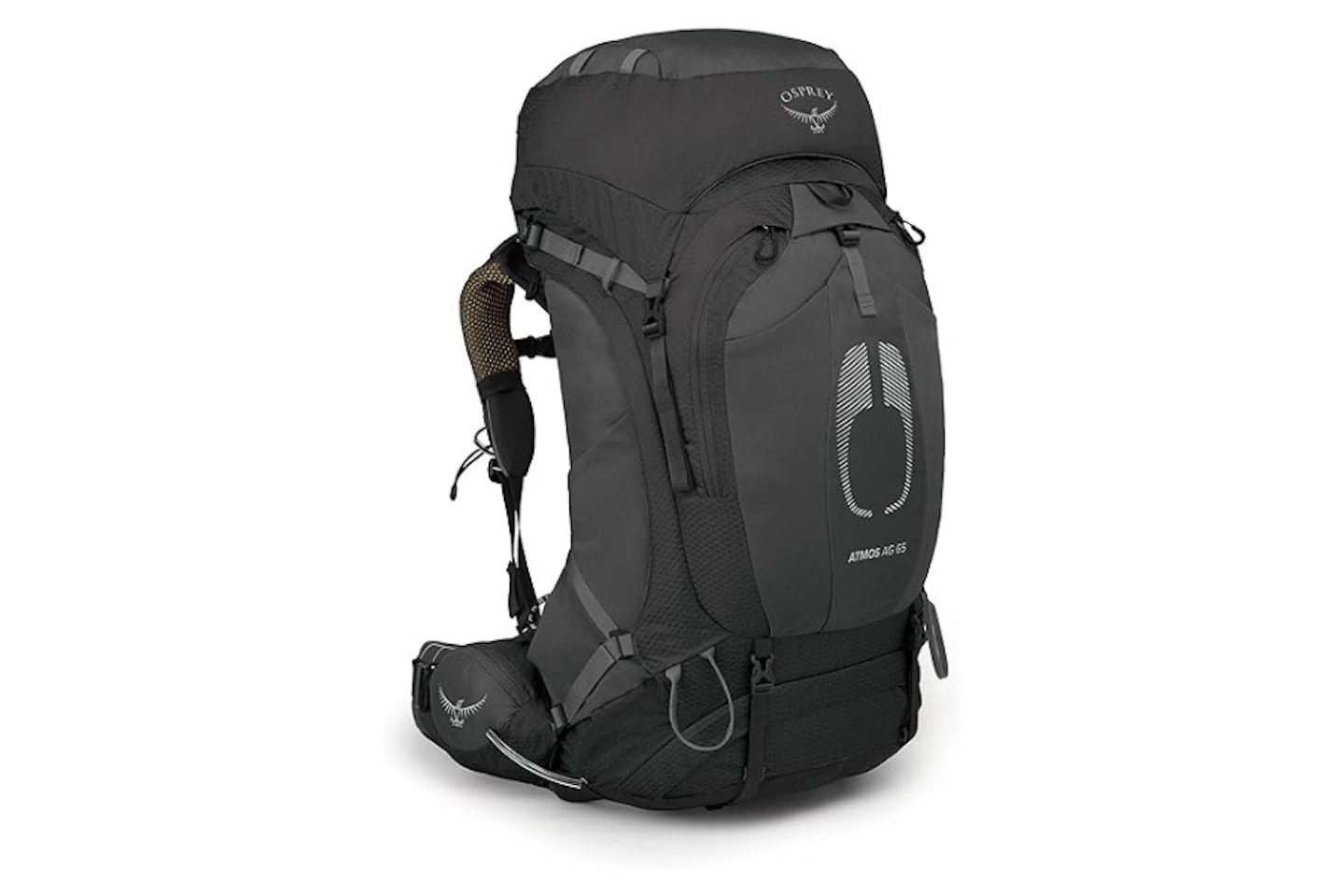 Osprey
Osprey The Osprey Atmos AG 65's anti-gravity (AG) trampoline-style back system holds the body of the pack away from the body of the wearer, to provide maximum airflow with exceptional comfort. The fit is made even better thanks to the hip belt, which moulds to the body for a secure fit. The Osprey Herren has great weight transfer of the load to the hips, due to the stiffness of the design, and loads are carried with good stability.
The main compartment of the Atmos AG 65 has a top entry with a floating lid and an additional flap jacket cover that allows you to remove the lid if needed. There are two massive front-zipped pockets behind the stretch stash pocket and you get pretty much all the packing options you need here.
However, the Atmos AG 65 is a heavy pack, although the weight does include a 123g rain cover, which is removable, it hardly makes a difference to the overall pack load.
It would have been good to have just a normal draw corded snow lock extension under the lid and ditch the flap jacket, but that is the only drawback here. Like many floating lid designs, water could creep under the back of the lid and make its way into the main compartment if you are not careful with the adjustment of the lid in the rain.
Though the price of the Osprey Atmos AG 65 is high, you are getting improved comfort and better stability in some cases for the extra cash.
A superb large travel backpack for a long camping weekend, with plenty of comfort to keep your mind on the road, it's tough to top this brilliant backpack. The Osprey Atmos AG 65 is a must for the most dedicated backpackers needing a reliable backpack to kick off their adventure.
Pros
- Excellent quality backpack
- Fantastic support for longer journeys
- Great waterproofing
Cons
- Fairly heavy pack size
| Capacity: | 65 |
| Materials: | bluesign® approved recycled 210D honeycomb nylon, PFC/PFAS-free DWR, |
| Available sizes: | One size |
| Additional features: | Fit-on-fly harness, hip belt, curved zips, integrated rain cover |
| Weight: | 2.1 kg |
Best for travel
 Lowe
Lowe The Lowe Alpine Sirac is great for travel, with a tough carry strap on the front which makes this rucksack easier to lob into luggage racks. The back system allows the shoulder straps to be raised and secured comfortably, and there's a mesh covering sitting against the body to increase airflow. The hip belt is particularly wide, stiff, and well-padded. You get mesh wand pockets on the side and compression straps.
However, the Sirac 65 litre backpack appears heavy compared to others, but it includes a very robust removable backpack rain cover, so remove this and the weight comes down. The carry is slightly unusual as the hip belt is exceptionally supportive, the shoulder straps are a little narrow and the back panel tends to barrel a little to create a firm contact area in the middle of the back.
Also, as with others, the floating lid design needs careful adjustment to stop water from creeping into the main compartment. Overall, the Low Alpine Sirac is perfect for travel, and if you ditch the rain cover the weight is good, but carry and comfort could be better.
Pros
- Adjustable hip belt
- Walking pole and axe attachment
- Huge amount of pockets
Cons
- Carry is slightly difficult
| Capacity: | 65+10 litres |
| Materials: | Made from 50 per cent recycled 420D Dobby and 100 per cent recycled 600D PW, HydroShield |
| Available sizes: | M-L |
| Additional features: | Air Contour X™ carry system, lash points, Air Contour X™ carry system, dual access side stretch mesh pockets |
| Weight: | 1.92 kg |
Best budget 65L backpack
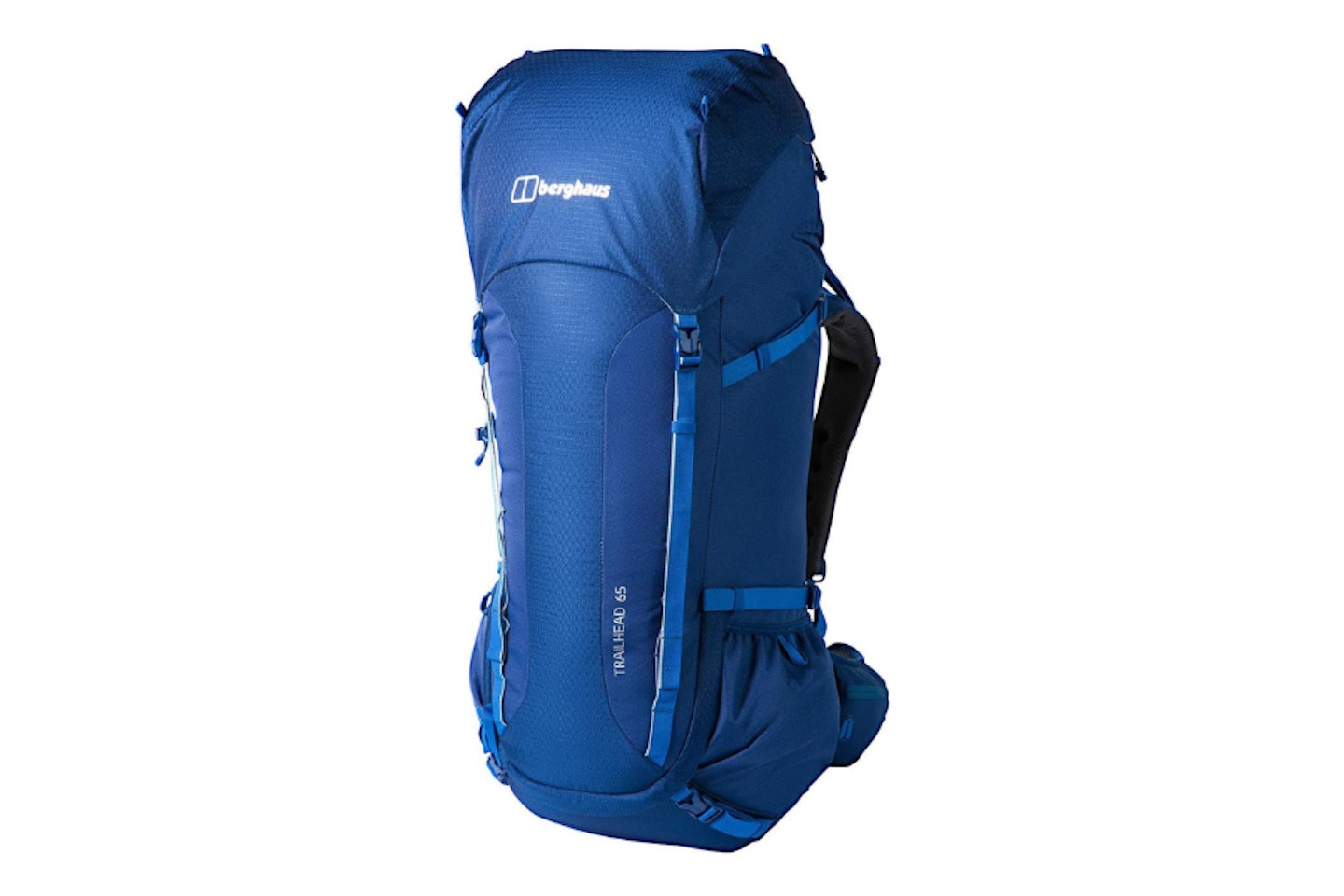 Berghaus
Berghaus For comfort and quality at an affordable price, the Berghaus Trailhead 65 is a tough rucksack to beat. Perfectly adjustable, thanks to its BIOFIT system and added padding for a stellar hiking holiday, the Trailhead 65 's ample support is certainly commendable.
Entry to the main compartment of the Trailhead 65 is via the lid, and there's a host of additional storage pockets under the compression straps and above the mesh wand pockets which are excellent for efficient supply access when quick access to tools is a must. On the back, the raised padded areas allow reasonable airflow, giving you that little extra comfort on sweltering summer days.
Unfortunately, there are some downsides when it comes to the Trailhead's design, namely relating to its tough front zips which can be slightly tricky to access. Yes, the YKK zips are incredibly reliable, but unzipping in a pinch can prove frustrating.
For a well-priced 65-litre backpack from one of the most reputable brands on the market, the Berghaus Trailhead is a top-tier choice for total peace of mind, rain or shine.
Pros
- Raised padded areas allow good airflow to avoid over-heating
- Separated compartment for wet gear
- Good amount of pockets
Cons
- Lacks in larger external pockets that zip
| Capacity: | 65 litres |
| Materials: | Not specified |
| Available sizes: | One size |
| Additional features: | BIOFIT™ back system for adjustable comfort, pre-curved hip belt for support, hydration system compatible, rain cover, walking pole attachments, separate bivi compartment |
| Weight: | 1.9 kg |
Best expedition 65L backpack
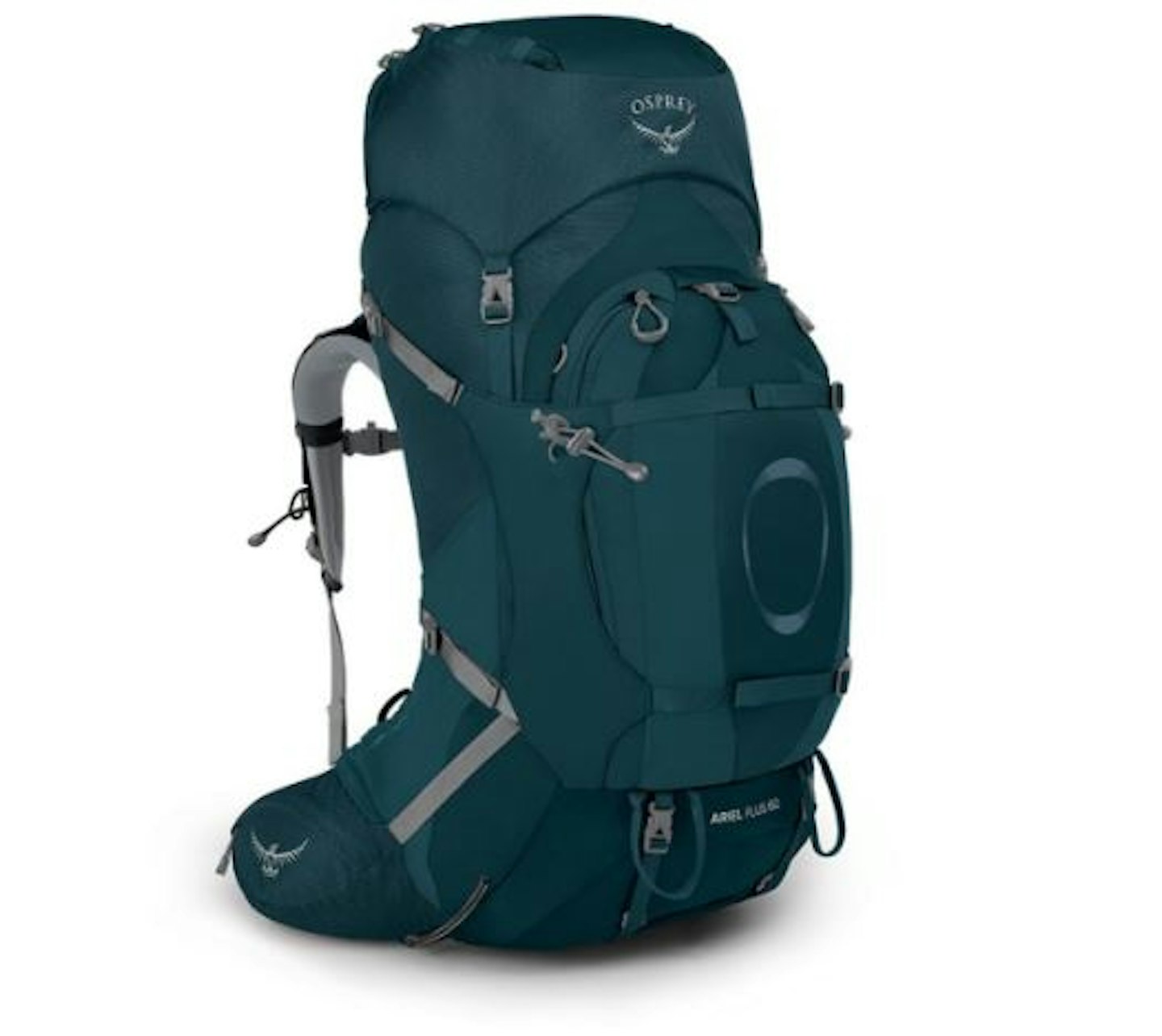 Osprey
OspreyThe Osprey Ariel Plus 60 is a rucksack for serious adventurers looking for total comfort and convenience on their journeys. With its array of features and particularly robust build quality, the Osprey Ariel Plus 60 verges from a backpacking rucksack to a full-on expedition pack. There are dedicated men’s and women’s models (the men’s is the Aether Plus 60), with two sizes for each. The back length is also adjustable. You can further fine-tune fit, as the ‘fit-on-the-fly’ shoulder straps and hip belt can be extended to suit.
The Ariel Plus offers main and bottom compartments, with front-zipped access to the main body as well as via the lid. For the best-prepared backpacker, there's a multitude of pockets and plenty of webbing to lash additional kit to the front or bottom of the pack. The removable lid even converts into a day or summit pack to reduce the overall weight, which is a must for backpacks of this size.
The Ariel Plus 60's Airscape back panel doesn’t offer quite the same ventilation as a suspended back system, but balances airflow with load-carrying stability. Even on technical trails with tricky-to-manoeuvre terrain, the Ariel Plus 60 feels evenly weighted.
Tough, extremely well-built and a highly capable gear-hauler, the Osprey Ariel Plus 60 is a hefty rucksack that's ready for use on vast expeditions.
Pros
- Custom-fit on-the-fly hip belt and shoulder strap
- Stable close-to-body carry - great for heavy loads
- The removable top lid can be used as a DayLid daypack
Cons
- Ventilation isn't as good as other backpacks on our list
| Capacity: | 60L |
| Materials: | Constructed from 210-denier high-tenacity nylon; bluesign® approved for environmental friendliness. |
| Available sizes: | XS/S with 58 litres, M/L with 60 litres |
| Additional features: | Custom Fit-On-The-Fly™ Hipbelt and Shoulder Strap, Removable top lid that converts to a daypack, close-to-body carry, PFC-free DWR water repellant |
| Weight: | XS/S: 2.46 kg, M/L: 2.49 kg |
Best environmentally friendly 65L backpack
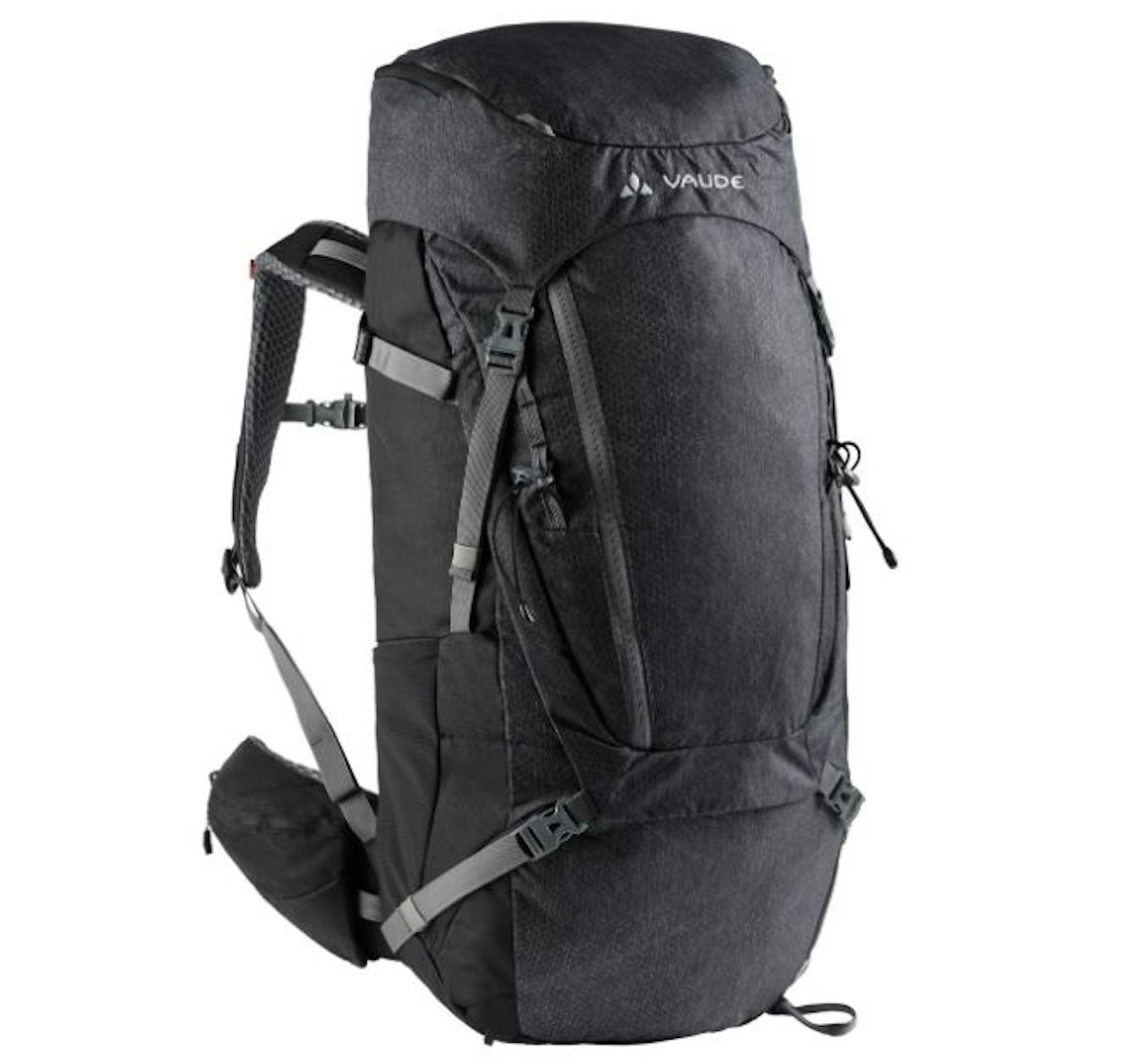 Amazon
Amazon The low weight is the instant appeal of the Vaude Asymmetric rucksack, coupled with its competitive price, but it's also made sustainably, adhering to Bluesign Fair Wair Foundation standards, and uses more eco-friendly waterproof treatment on the materials. The back length of the Vaude Asymmetric is adjustable, with perforated mesh which provides airflow across the padded body contact areas.
The main compartment has a base, front, and top entry via a floating lid, and there's a huge front pocket that's perfect for storing your camping necessities. The compression straps work well with the deep mesh side wand pockets that are perfect for storing pickets and tent poles. The carry is acceptable with light loads, and some will like the relatively firm and stable feel of this pack, and that the weight transfers well to the wide hip belt.
This rucksack is unfortunately quite firm in body contact areas and there is less airflow across the back, so it's best used with lighter loads to compensate. The capacity is smaller than other rucksacks too, so you do need to have the lid and pockets expanded fully to reach a similar capacity to others. Many higher-priced rucksacks use more durable nylon, rather than the polyester used here. Like others, the floating lid needs to be carefully managed to ensure no water creeps in, although this one does cover the top of the pack better than most. The lid pocket zip does not get an external storm flap, so it leaks more easily than others.
A great lightweight rucksack for use with smaller and lighter loads, but not the most comfortable option, the Vaude Asymmetric backpack is fantastic for environmentally-conscious buyers looking for a reliable backpack with plenty of space for all of your camping snacks and supplies.
Pros
- Height-adjustable, back-friendly carrying system
- Made from mostly recycled materials
- Great for hut tours, alpine trekking, pilgrimages and backpacking
Cons
- Hand wash only
| Capacity: | 52+8 litres |
| Materials: | Main fabric is 79% Polyamide, 21% Polyester with 400 D Diamond Ripstop Polyurethane coating; contrast fabric is 100% Polyester (50% recycled) |
| Available sizes: | One size with adjustable back length |
| Additional features: | Tergolight suspension system for stability, integrated frame, multiple access points, environmentally friendly, removable lid, gear loops |
| Weight: | 1.53 kg |
Best North Face 65L backpack
A comfortable and highly adjustable backpack from North Face, the reasonably priced Terra 65 litre hiking backpack is suitable for those on longer treks in need of reliable suspension. Using North Face's Dyno Lift System™, hikers can adjust the balance of the Terra 65-litre hiking backpack on the go to reduce strain on their shoulders and back for a much more even distributed weight system.
The build quality of the Terra hiking backpack is fantastic for the drizzly British weather, made of 210D nylon and 600D polyester with a water-repellent finish for total dryness, which is essential whilst backpacking.
As for storage, the sizeable 65-litre backpack has plenty of pockets and subsections which prove useful when overburdened with camping tools and dirty clothes, its hip belt pockets proving particularly useful for grabbing a quick snack.
The major downside to the Terra backpack has to be its lack of rain cover, its absence being slightly concerning for those facing stormy conditions with unrelenting rain.
For all intents and purposes, however, North Face's Terra 65-litre backpack is a must for hikers thanks to its convenient design with plenty of storage space for all of your camping essentials, with spare room for some small comforts too.
Pros
- Great design from North Face
- Plenty of pockets and subsections for total organisation
- Fantastic Dyno Lift System
Cons
- No rain cover included
| Capacity: | 65 litres |
| Materials: | 210D nylon and 600D polyester with DWR finish |
| Available sizes: | Small/Medium and Large/X-Large |
| Additional features: | OPTIFIT™ suspension system, Dyno Lift System™, floating lid, Hydration sleeve compatible |
| Weight: | XS/S: 1.84 kg, M/L: 1.96 kg |
Best spacious 65 litre backpack
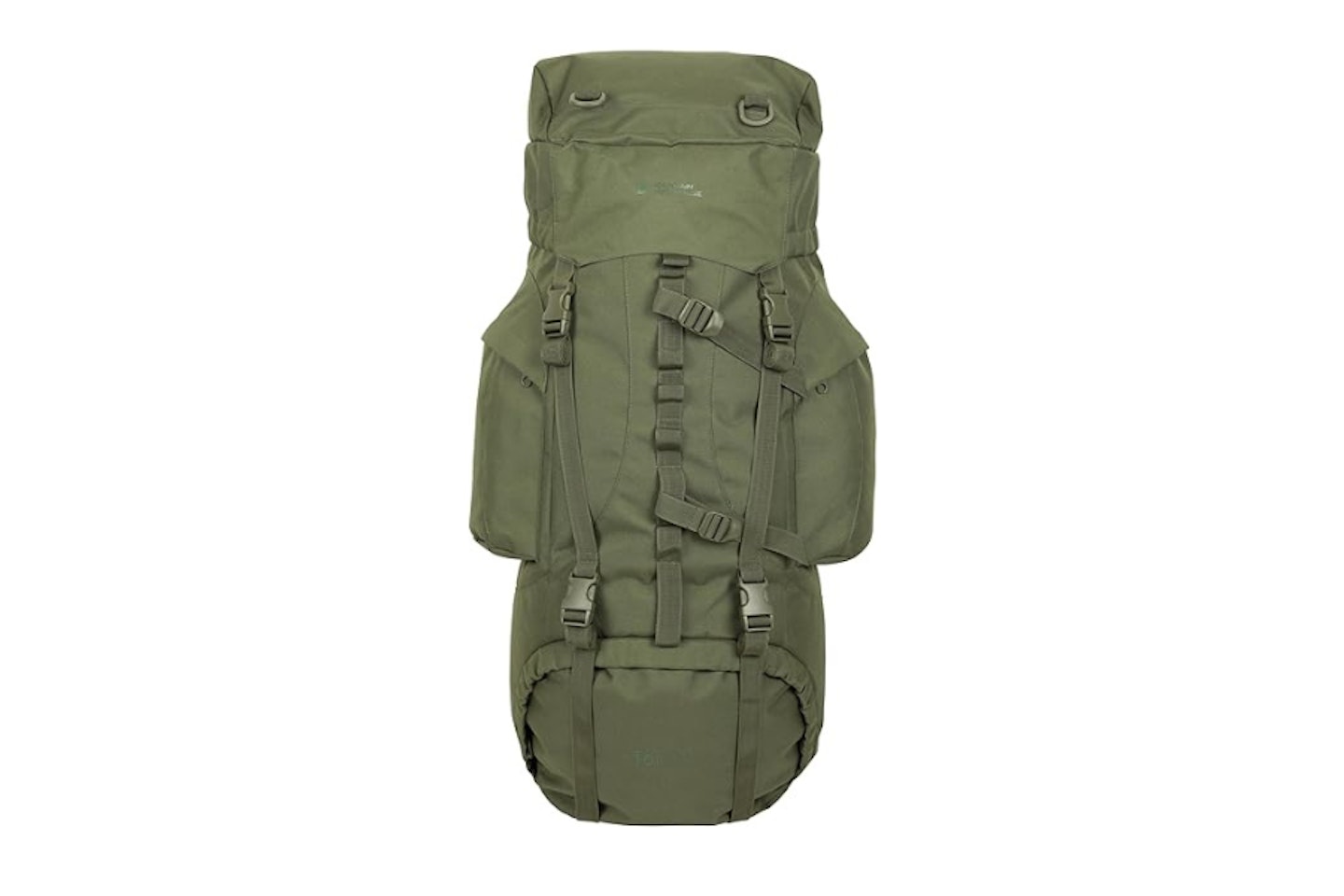 Mountain Warehouse
Mountain Warehouse For less than £60, the Mountain Warehouse Tor 65-litre backpack is at a truly competitive price and is perfectly ideal for those packing plenty for their hiking journey. Made to simplify your camping journey, the Tor backpack's huge side pockets and divideable storage make it perfectly ideal for separating muddy gear, with a bottom zip for instant access to the main compartment making storage even simpler.
Made of tough polyester, this highly water-resistant backpack looks and feels tactical, which is more than impressive at its price. Clipping gear to the rear of the backpack is made incredibly easy by its vast array of loops, which are ideal for attaching foam rolls or other typically space-wasting equipment. Carrying even the best two-man tent is incredibly easy in this reliable backpack.
There are undoubtedly limitations you should consider before buying a cheaper 65-litre backpack, however, such as its general lack of exciting features that you might find on more expensive models. Then, there's the fairly poor ventilation and lack of padding on the Tor, which doesn't offer much in the way of breathability.
For a tough-to-beat price, this spacious backpack with large side pockets might just be one of the best 65-litre backpacks of the year.
Pros
- Excellent value 65-litre rucksack
- Spacious pockets for extra storage
- Solid khaki design
Cons
- Fairly basic features
| Capacity: | 65 litres |
| Materials: | Padded air mesh, polyester |
| Available sizes: | One size with an adjustable back system |
| Additional features: | Dividable compartments, load balance adjuster, multiple storage pockets |
| Weight: | Not specified |
Best 65L for comfort
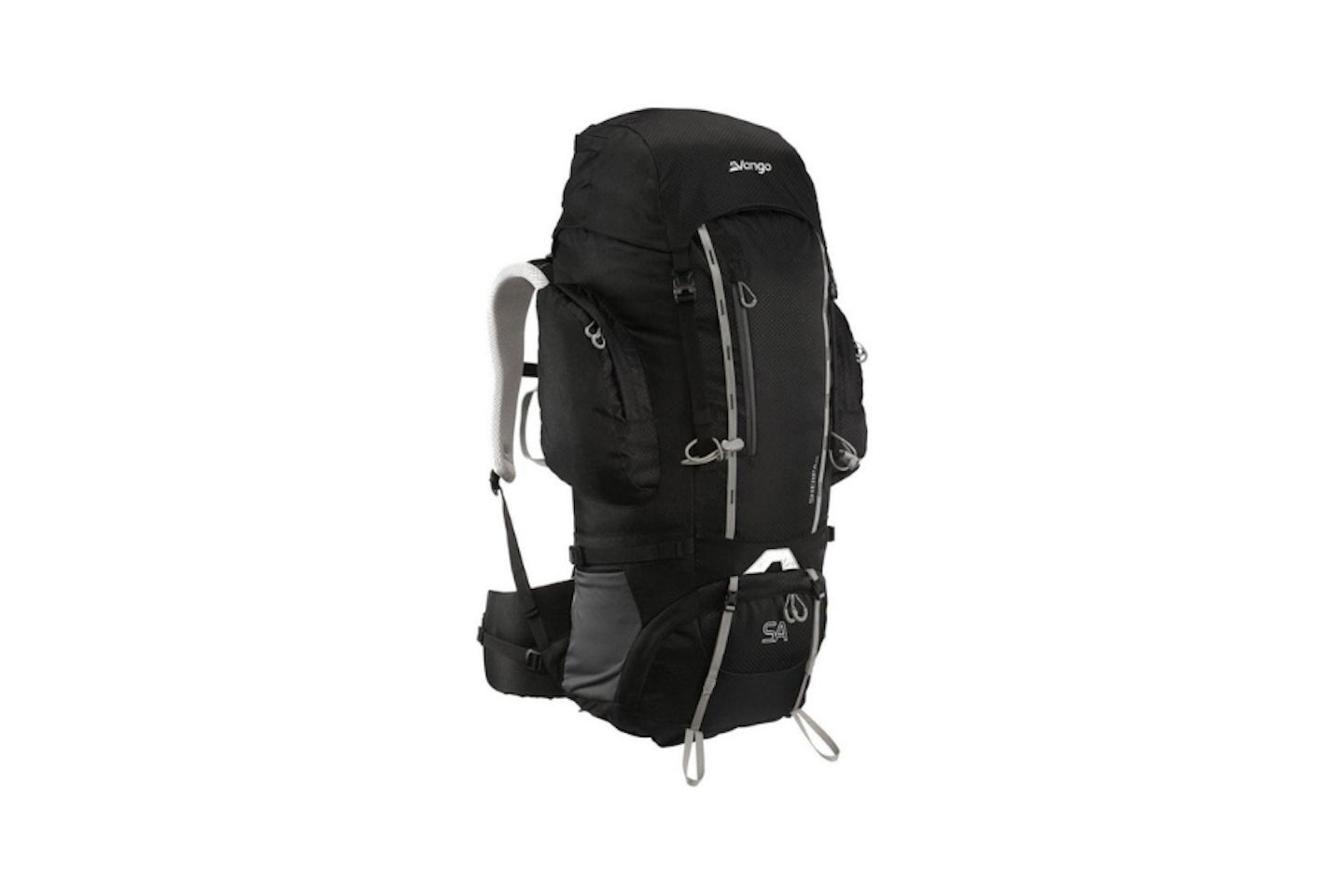 Vango
Vango The perfect rucksack for absolute backpacking comfort, the Vango Unisex Sherpa 65L backpack is certainly one of the most plush, forgiving backpacks on the market, which combines a hip belt, and adjustable back straps for total backpacking balance.
Highly adjustable with a thick air mesh for strong breathability, the Vango Sherpa's design ensures that even the longest of off-the-road adventures are walked comfortably, even in the poorest conditions - heavy rain included. If you've got a lot to pack, the Sherpa's compression straps allow for a little extra room, which is always handy when you're far from civilisation.
If there's anything to criticise about the Vango Sherpa, it's certainly worth criticising the overall weight of the design, which is around 2.5 kg. This extra bulk, especially when fully packed can send your pack load over the edge, making your trek all the more challenging.
However, pack strategically, and the Vango Sherpa will serve you well, wherever you find yourself. A phenomenal backpack at an impressive value, this tough backpack is bound to keep you comfortable, all without breaking the bank.
Pros
- Incredibly comfortable mesh design
- Fantastic Vango build quality
- Highly adjustable back support for one-size use
Cons
- Fairly heavy at 2.5 kg
| Capacity: | 65 litres |
| Materials: | 1680D Polyester base fabric, 600D Polyester fabric, Air Mesh |
| Available sizes: | One size with an adjustable back system |
| Additional features: | Self-adjust back system, integrated rain cover, dual side compression straps, pro-weave side pocket |
| Weight: | 2.5 kg |
Prime Day Deal: 35% off
Best 65L backpack for breathability
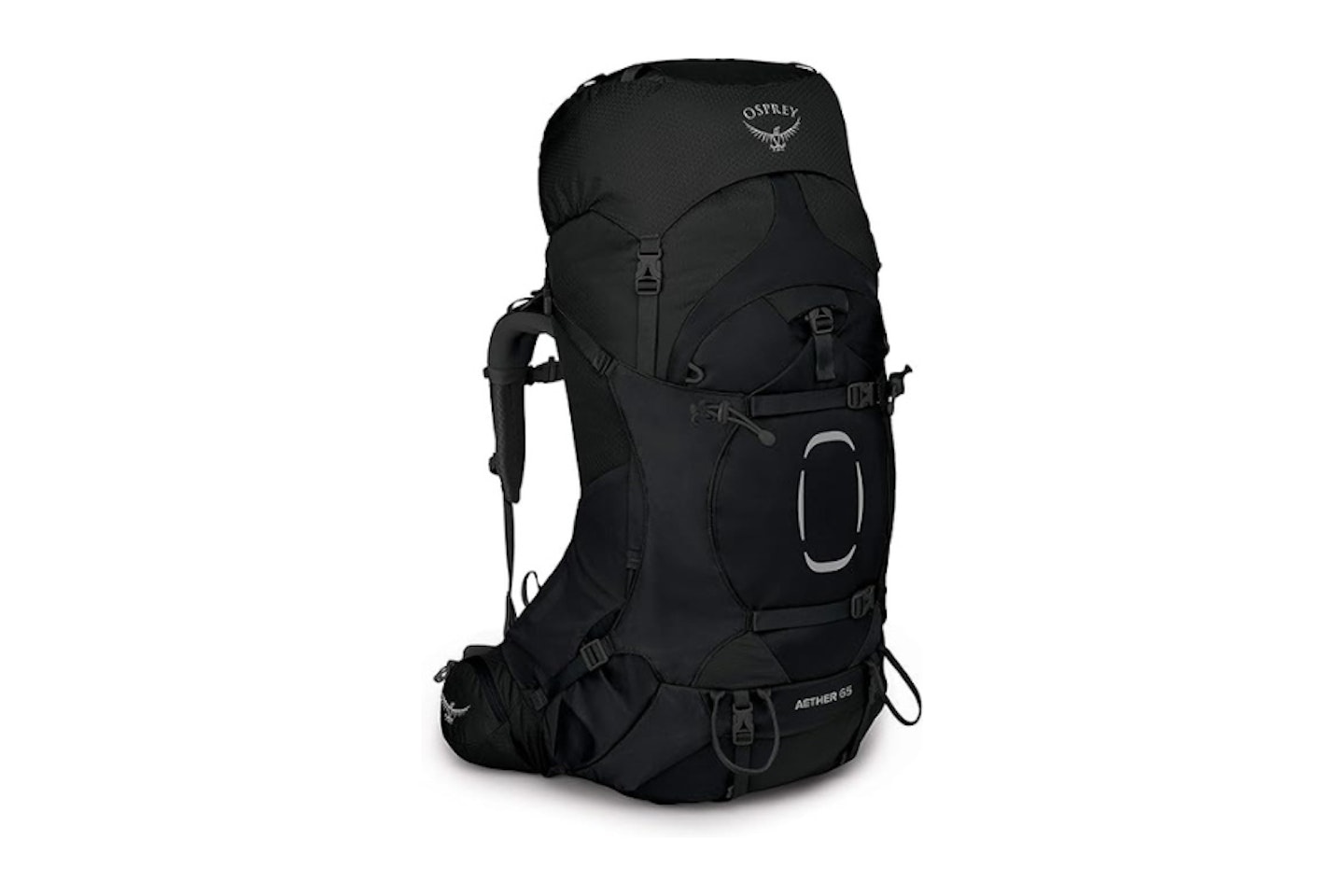
Osprey's Aether 65 hiking pack is certainly on the premium end of the 65-litre backpacking spectrum, and is reserved only for the most adventurous and deep-pocketed hikers. A seriously stunning backpack, with precise construction and design perfection, there are few features the Aether lacks. From compression straps, to an integrated rain cover and easy main compartment access, there are countless great features, but nothing beats its Fit-on-the-Fly™ shoulder strap system.
Incredibly easy to adjust on-the-go, with several adjustable straps for total balance, the Osprey Aether has fantastic shoulder and back support, and a hip belt that is unparalleled in comfortability. We also love the breathability of the backplate, with its vast ventilation spaces that keep your back perfectly cool.
Aside from its high price, our main criticism with the Osprey Aether has to be its bulkier size, which feels massive, especially thanks to its thick padding. Yes, the weight adds a bit of bulk, but it's the thickness of the Aether that may leave campers feeling overburdened.
When in use, however, there's no denying the sheer quality of the Osprey Aether, its fine construction, the array of side pockets and deep front pockets make for a highly convenient backpack that makes the toughest walks all the more bearable.
Pros
- Ultra-comfortable mesh design
- Hard to beat build quality
- Includes rainproof cover
Cons
- Fairly bulky
| Capacity: | 65 litres |
| Materials: | 420HD nylon packcloth, DWR, 210D nylon Diamond |
| Available sizes: | S/M, L/XL |
| Additional features: | Fit-on-the-Fly™ Shoulder Straps and Hipbelt, AirScape™ backpanel, Included rain cover, access to the main compartment via front zip, Dual access side stretch mesh pockets, upper and lower compression straps |
| Weight: | S/M: 2.2 kg, L/XL: 2.25 kg |
Best 65L backpack under £30
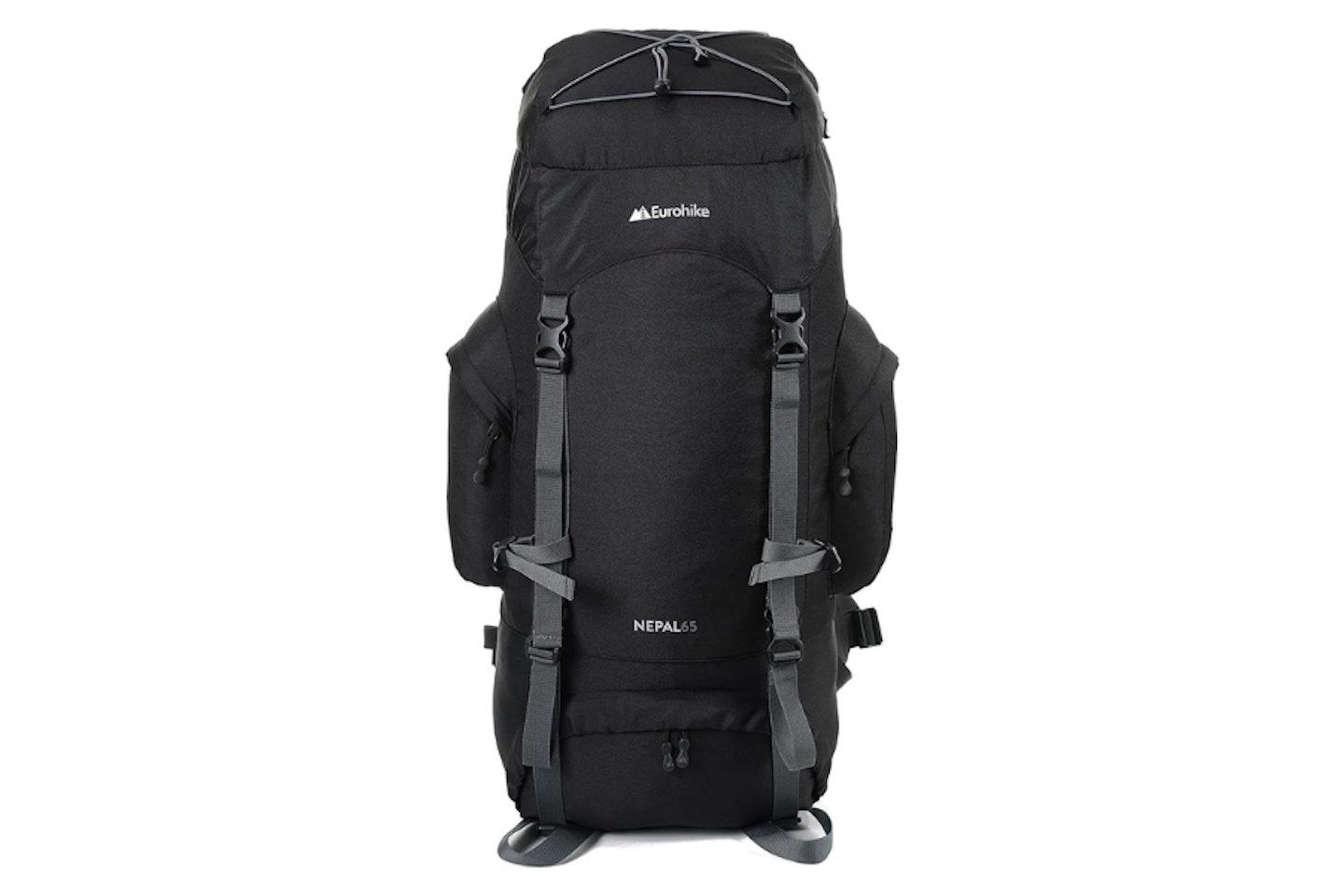 Eurohike Nepal Rucksack 65L
Eurohike Nepal Rucksack 65LIf you're in a pinch and low on funds, save your much-needed cash for your other camping supplies, try spending £30 on a fantastic 65-litre backpack. A slick and surprisingly well-made rucksack that's enough for long trails, Eurohike's Nepal rucksack is incredibly spacious, despite its fairly limited pockets.
Attach gear with the simple cord if you're out of space, or pull the Eurohike Nepal shut with its compression straps, don't leave behind equipment that'll give you the edge in your hiking experience.
Of course, at a fraction of the price of its competitors, there are cutbacks to the Nepal's design: there's a sheer lack of breathability on the backpack, with a particularly flat design that doesn't leave much room for ventilation. Then, there's the thinner hip belt and limited shoulder straps, which aren't as 'one-size' as other backpacks are.
For the price, however, you cannot really complain over these minor issues: this backpack is truly terrific value, and is unbeatable for this fact alone.
Pros
- Ultra lightweight backpack
- Great value for money
- Sturdy aluminium back frame
Cons
- Not as comfortable as pricier backpacks
| Capacity: | 65 litres |
| Materials: | Not specified |
| Available sizes: | One size with adjustable straps |
| Additional features: | Ventilated mesh back panel, aluminium back support, walking pole attachment |
| Weight: | 1.38 kg |
A buyer's guide to 65-litre backpacks
How to fit a rucksack
It is impossible to stress how important proper fitting is. A properly fitted rucksack distributes the load as it should, so you don't have excess stress on your body. Fitting your rucksack is best done with a practical demonstration. Check out Go Outdoors' video below:
What does the "65L" capacity mean?
The capacity of a rucksack is measured in litres (L), indicating the volume of the main storage compartment. A 65L rucksack has a capacity of 65 litres, which is considered large and suitable for multi-day trips or extended travel.
Is a 60L or 65L rucksack too big for day hikes?
Yes, a 60+L rucksack is generally too large for day hikes. It is designed for longer trips where you need to carry more gear and supplies. For day hikes, a smaller backpack with a capacity of around 20-35L is more appropriate.

FAQs: your questions answered
Can a 60L or 65L rucksack be used for air travel?
Yes, a 65L rucksack can be used for air travel, but it may need to be checked in as luggage due to its size. Different airlines have specific regulations regarding the size and weight of carry-on baggage, so it's important to check with the airline beforehand.
How much weight can a 65L rucksack carry?
The weight-carrying capacity of a 65L rucksack varies depending on its design and build quality. Most well-constructed packs can comfortably carry 15-20 kilograms of weight. It's important to consider your own strength and comfort level when determining how much weight to carry.
Can a 65L rucksack be used for backpacking?
Yes, a 65L rucksack is commonly used for backpacking trips and trekking. It offers enough space to carry all the necessary gear, clothing, food, and other essentials needed for extended trips in remote areas. However, it's important to pack efficiently and avoid overpacking to prevent excessive weight and discomfort.
William Lobley is the Editor for What's The Best. Here, he oversees, curates and researches listicles and reviews as many products as his home office can handle.
He has spent nearly five years writing about tech, audio, outdoors and fitness and has reviewed everything from smartphones to ice baths. In addition, he's well-versed in sniffing out the best deals and savings the internet offers.
When not at his desk writing, reviewing or deal-hunting, he'll be relaxing with Japanese crime novels, bingeing some classic anime, strolling the countryside or at the gym listening to the heaviest metal Spotify has to offer.
Subscribe to the What’s The Best Newsletter to keep up to date with more of the latest reviews and recommendations from the What’s The Best team.
